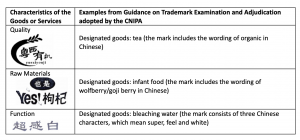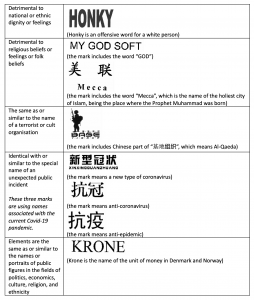The National Intellectual Property Administration of China (CNIPA) issued the Standard for Judging General Trademark Violations (Standard) on December 13, 2021. It entered into force on January 1, 2022.
Background
In China, the Administration for Market Regulation (AMR) at the state, provincial, municipal and county levels (including all branches) are the enforcement authority tasked with administering and regulating trademark use. The authority takes ex-officio action against trademark violations or initiate actions based on complaints filed by third parties.
Given the complex and diversified nature of trademark use and disputes, administration requires a detailed understanding of relevant laws and regulations. Typically, relevant trademark laws and regulations in China are usually prescribed as principles, which can be difficult for front-line administrative officers to apply in practice.
To better implement the relevant trademark laws and regulations, front-line administrative officers need specific guidance. Therefore, the issuance of the Standard is aimed at providing specific applicable guidance in assisting trademark administration.
The issuance of the Standard is aimed at providing specific guidance to assist trademark administration, while creating a transparent and predictable intellectual property protection regime for all market participants.
Summary
Chinese Trademark Law regulates two kinds of violations:
- Trademark infringement that infringes the exclusive right of a specific party; and
- Acts that violate the order of trademark administration and damage the public interest.
The general trademark violations stipulated in the Standard refer to violations against trademark administration and that damage the public interest.
The Standard includes 35 articles detailing different types of general trademark violations with concrete guidelines and applicable laws and regulations to determine trademark violations.
Below is a summary of the types of general trademark violations and the relevant guidelines found in the articles of the Standard.
1. In violation of Article 6 of the PRC Trademark Law, failing to use a registered trademark where it is mandatory
Article 4
In accordance with Article 6 of the Trademark Law, Article 19 of the Law of the People’s Republic of China on Tobacco Monopoly, and Articles 22 and 65 of the Detailed Rules for the Implementation of the Tobacco Patent Sales Law of the People’s Republic of China, new varieties of tobacco products such as cigarettes, cigars, packed tobacco, and e-cigarettes shall bear registered trademarks and shall not be produced or sold in China before the trademarks are registered in China.
Trademarks registered in China must be used to sell imported cigarettes, cigars, packaged tobacco, e-cigarettes and other new varieties of tobacco products in China.
2. In violation of Article 10 of the PRC Trademark Law, using signs that shall not be used as trademarks
Articles 5 to 17
Article 5 – whether the use of an unregistered trademark violates Article 10 of the Trademark Law shall generally be judged by the common knowledge of the public within China.
However, there is an exception if there is any reasonable and sufficient reason to prove that the specific public within the territory of China believe that the use of an unregistered trademark violates Items 6 to 8, Paragraph 1 of that Article.
Article 6 – the Guide on Trademark Examination and Adjudication may be used as a reference when judging whether the unregistered trademarks used are identical or similar to the signs as prescribed in Paragraph 1 of Article 10 of the Trademark Law.
Article 7 – the discrimination against any race as prescribed in Item 6, Paragraph 1 of Article 10 of the Trademark Law means the use of words, graphics, or other constituent elements of an unregistered trademark with content that vilifies, degrades, or otherwise treats a particular race in an unequal way.
Article 8 – the fraud prescribed in Item 7, Paragraph 1 of Article 10 of the Trademark Law means that the representation of a trademark about the quality and other characteristics or the origin of a product or service used exceeds its inherent degree or is inconsistent with the facts, which easily misleads the public about the quality and other characteristics or the origin of the product or service.
However, there is an exception if the public, based on their daily life experience, will not misidentify the quality and other characteristics or the origin of the product or service.
Article 9 – if an unregistered trademark that is being used falls into any of the following circumstances, such act shall constitute fraud under Item 7, Paragraph 1 of Article 10 of the Trademark Law:
1. it easily misleads the public about the characteristics of a product or service such as quality, main materials, functions, usage, weight, and quantity;
2. it easily misleads the public about the origin of a product or service; and
3. any other representation about the quality and other characteristics or the origin of the product or service used exceeds its inherent degree or is inconsistent with the facts, which easily misleads the public.
Article 10 – those detrimental to socialist morals or customs as prescribed in Item 8, Paragraph 1 of Article 10 of the Trademark Law means those marks that impair the standards and norms governing the common life of the Chinese public and their behaviors, as well as the good customs and habits prevailing in society in a certain period of time.
Article 11 – other unhealthy influences as prescribed in Item 8, Paragraph 1 of Article 10 of the Trademark Law means that the words, graphics, or other constituent elements of a sign have derogatory meaning, or the sign itself, although having no derogatory meaning, is used as a trademark, which is liable to have negative or adverse influences on social public interests such as politics, the economy, culture, religion, or ethnicity and public order in China.
Article 12 – an unregistered trademark being used shall be determined as having other unhealthy influences as prescribed in Item 8, Paragraph 1 of Article 10 of the Trademark Law under any of the following circumstances:
1. where it endangers national security or national unity;
2. where it is detrimental to the sovereignty, dignity, or image of the State;
3. where it is detrimental to national or ethnic dignity or feelings;
4. where it is detrimental to religious beliefs or feelings or folk beliefs;
5. where its name is the same as or similar to the name of a terrorist or cult organization;
6. where its name is the same as or similar to the special name of an unexpected public incident;
7. where it or its constituent elements are the same as or similar to the names or portraits of public figures in the fields of politics, economics, culture, religion, and ethnicity, which cause negative or adverse influences on social public interests or public order; and
8. where it causes any other negative or adverse influences on public interests and public order.
Article 13 – to judge whether the use of an unregistered trademark is detrimental to socialist morals or customs or has other unhealthy influences, the following factors and the interaction among them shall be taken into comprehensive consideration:
1. the political background, social background, historical background, cultural tradition, ethnic customs, religious policies, etc. when the trademark is used;
2. the constituent elements of the trademark and the product or service for which it is used; and
3. the subjective intention of the user, the way of use, and the social impact of use.
The daily life experience of the public, or the records in dictionaries or reference books, or the general understanding of the relevant public may be used as the basis for judging whether a trademark is detrimental to socialist morals or customs or has other unhealthy influences.
Article 14 – an unregistered trademark being used has multiple meanings, and if one meaning is easy for the public to believe that it falls under any of the circumstances as specified in Items 6 to 8, Paragraph 1 of Article 10 of the Trademark Law, it may be deemed as a violation of that paragraph.
Article 15 – where the China National Intellectual Property Administration determines that an application for trademark registration violates Article 10 of the Trademark Law and the trademark applicant or others continue to use the trademark after the relevant decision or ruling takes effect, the department responsible for trademark law enforcement shall investigate and deal with such violation in accordance with the law.
Article 16 – where a department responsible for trademark law enforcement finds that a registered trademark is suspected of violating Article 10 of the Trademark Law, it shall report the case to the China National Intellectual Property Administration level by level, which shall deal with it in accordance with the law according to the prescribed procedures. Where a trademark registrant or any other person continues to use a registered trademark after the China National Intellectual Property Administration makes the decision to declare the registered trademark invalid, the department responsible for trademark law enforcement shall investigate and deal with it in accordance with the law.
3. In violation of Article 14 (5) of the PRC Trademark Law, using the words well-known trademark in commercial activities
Article 17
In the case of a violation of Paragraph 5 of Article 14 of the Trademark Law, it shall be handled in accordance with Article 53 of the Trademark Law and Article 33 of the Law of the People’s Republic of China on Administrative Penalties with the circumstances, harmful consequences, subjective fault, and other factors of the violation taken into comprehensive consideration.
4. In violation of Article 43(2) of the PRC Trademark Law, the trademark licensee fails to indicate its name and the place of origin of the goods
No corresponding guidance in the Standard
5. In violation of Article 49(1) of the PRC Trademark Law, changing the elements of a registered trademark or the name, address or other registration items without approval when using the registered trademark
Articles 18, 19, 20, 21 and 24
Article 18 – for the purpose of Paragraph 1 of Article 49 of the Trademark Law, alteration to a registered trademark without approval means that a trademark registrant makes partial alteration to or changes the relative position of the words, graphics, letters, numbers, three-dimensional signs, color combinations, sounds, and other constituent elements of a registered trademark without approval, which affects the recognition or identification of the registered trademark, but the trademark is still labeled as a registered trademark or registered sign.
Article 19 – where the integral package of cigarettes is registered as a trademark, the change and use of the cigarette trademark due to the addition of warning words or the modification of warning words and the area of the warning zone made in accordance with the relevant regulations of the State shall not be deemed as a violation of Paragraph 1 of Article 49 of the Trademark Law.
Article 20 – any of the following circumstances shall be deemed as an alteration to the registration items of a trademark without approval as prescribed in Paragraph 1 of Article 49 of the Trademark Law:
1. failure to record the change to the China National Intellectual Property Administration after the trademark registrant changes its name;
2. failure to record the change to the China National Intellectual Property Administration after the address of the trademark registrant changes or the actual address of the trademark registrant is inconsistent with the address recorded in the Trademark Register; and
3. failure to record the change to the China National Intellectual Property Administration after any registration item other than the name or address of the trademark registrant changes.
Article 21 – where a trademark registrant alters a registered trademark or the name, address, or other registration items of the registrant without approval, the department responsible for trademark law enforcement shall order it to make corrections within a time limit; if it fails to make corrections within the time limit, the department responsible for trademark law enforcement shall report the case to the China National Intellectual Property Administration level by level, which shall handle it in accordance with the law according to the prescribed procedures.
Article 24 – a trademark registrant shall supervise the licensee’s lawful use of its/his/her registered trademark. Where a trademark registrant fails to promptly stop the licensee from altering the registered trademark or the name, address, or other registration items of the registrant when the registrant knows or should know of such failure, the trademark registrant shall bear the legal liability for altering a registered trademark without approval.
6. In violation of Article 52 of the PRC Trademark Law, using unregistered trademarks as registered trademarks
Articles 22 to 23
Article 22 – for the purpose of Article 52 of the Trademark Law, using unregistered trademarks as registered trademarks / pretending to be a registered trademark means marking a registered trademark, or marking a registered sign on an unregistered trademark, or marking a symbol similar to a registered sign on an unregistered trademark on products, product packages, containers, service places, and transaction documents using the unregistered trademark, or in advertising, exhibition, and other commercial activities, to mislead the relevant public.
Article 23 – any of the following acts of a trademark registrant or user shall be deemed as using unregistered trademarks as registered trademarks / pretending to be a registered trademark as stipulated in Article 52 of the Trademark Law:
1. using a trademark with registered trademark or registered sign, for which no application has been filed with the China National Intellectual Property Administration;
2. using a trademark with registered trademark or registered sign, for which an application filed with the China National Intellectual Property Administration has been rejected or has not been approved;
3. after a registered trademark has been revoked, declared invalid, or canceled due to non-renewal upon expiration, or the cancelation application for the registered trademark has been approved, it continues to be indicated as a registered trademark or registered sign, except where the product has entered circulation before the invalidation of the registered trademark;
4. using a registered trademark on disapproved products or services with a registered trademark or registered sign indicated;
5. changing the distinctive features of a registered trademark with a registered trademark or registered sign indicated;
6. using a combination of more than two registered trademarks with registered signs indicated, but failing to indicate the registered signs one by one as per registered trademarks; and
7. using a trademark that has not been registered or declared in China on imported products marked with a registered trademark or registered sign.
Where the above-mentioned acts of a trademark registrant or user simultaneously constitute infringement of the exclusive right to use a registered trademark of another person as prescribed in Article 57 of the Trademark Law, the department responsible for trademark law enforcement shall investigate and deal with the case in accordance with Paragraph 2 of Article 60 of the Trademark Law; if a crime is suspected, the case shall be transferred to the judicial authority in a timely manner for handling in accordance with the law.
7. In violation of Article 4(2) of the Implementing Regulations of the PRC Trademark Law and Articles 14, 15, 17, 18, 20 and 21 of the Measures for Registration and Administration of Collective Trademarks and Certification Trademarks, failing to fulfill the obligations for administration of collective trademarks or certification trademarks
Articles 25 to 28
Article 25 – where a registrant of a collective trademark or certification trademark violates Paragraph 2 of Article 4 of the Implementing Regulations of the Trademark Law and Articles 14, 15, 17, 18, and 20 of the Measures for Registration and Administration of Collective Trademarks and Certification Trademarks, the department responsible for trademark law enforcement shall deal with such violation in accordance with Article 22 of the Measures for Registration and Administration of Collective Trademarks and Certification Trademarks.
Article 26 – where products produced by non-collective members meet the conditions for geographical indications, they may legitimately use the place names in the geographical indications, but are not entitled to use the collective trademarks registered as geographical indications.
Article 27 – where a registrant of a collective trademark falls under any of the following circumstances, it shall be deemed that the registrant fails to exercise effective administration or control over the use of the trademark as prescribed in Article 21 of the Measures for Registration and Administration of Collective Trademarks and Certification Trademarks:
- the member violating the rules on the use and administration of the collective trademark does not assume any liability;
- the inspection and supervision system for the products using the collective trademark is not in effective operation; and
- the registrant otherwise fails to exercise effective administration or control over the use of the trademark.
Article 28 – where a certification trademark registrant falls under any of the following circumstances, it shall be deemed that the registrant fails to exercise effective administration or control over the use of the trademark as prescribed in Article 21 of the Measures for Registration and Administration of Collective Trademarks and Certification Trademarks:
- the user violating the rules on the use and administration of the certification trademark does not assume any liability;
- the inspection and supervision system for the products using the certification trademark is not in effective operation; and
- the registrant otherwise fails to exercise effective administration or control over the use of the trademark.
8. In violation of Articles 7 to 10 of Regulations on Trademark Printing Administration, failing to fulfill obligations for administration of trademark printing
Articles 29 to 32
Article 29 – for the purpose of the Regulations on the Administration of the Printing Industry and the Administrative Measures for the Printing and Production of Trademarks, trademark signs refer to the tangible carriers with trademarks that enter the circulation sector together with the products, including registered trademark signs and unregistered trademark signs.
Trademark signs are generally independent of the marked products and do not have the functions of the products.
Article 30 – the printing and production of trademarks refers to the printing and production of trademark signs.
The marking of text or graphics of trademarks on products and components and parts and major raw materials of products (excluding the packaging of the products) by means of printing, dying and pressing shall be deemed as the production and processing of products and shall generally not be deemed as the printing and production of trademarks as mentioned in the preceding paragraph.
Article 31 – where a trademark printing and production entity undertakes to print a trademark sign marked with the words registered trademark or a registered sign, it shall, in accordance with Articles 3, 4, 5, and 7 of the Administrative Measures for the Printing and Production of Trademarks, verify whether the certification documents such as the Trademark Registration Certificate and the undertaken trademark are consistent with the trademark for which the Trademark Registration Certificate is approved and whether the registered trademark is valid. If the abovementioned verification obligations are not fulfilled, the department responsible for trademark law enforcement shall investigate and deal with it in accordance with the law.
Article 32 – where a trademark printing and production entity undertakes to print a trademark sign not marked with the words registered trademark or a registered sign, and fails to perform the following verification obligations, the department responsible for trademark law enforcement shall investigate and deal with it in accordance with the law:
- verification of the certification documents and the trademark pattern in accordance with Articles 3, 6, and 7 of the Administrative Measures for the Printing and Production of Trademarks; and
- enquiring of the official website of the China National Intellectual Property Administration to check whether another person has registered a trademark identical to the trademark sign applied to the same product or service.
Where another person has registered a trademark identical to the trademark sign applied to the same product or service, and the trademark printing and production entity still undertakes the printing and production, it shall be dealt with in accordance with Article 13 of the Administrative Measures for the Printing and Production of Trademarks.
9. In violation of Article 3 of the Several Provisions on Regulating the Application for Registration of Trademarks, maliciously applying for trademark registration
Article 33
Article 33 – a department responsible for trademark law enforcement may, when investigating and dealing with a malicious application for trademark registration, handle the case by reference to the effective decision or ruling of the China National Intellectual Property Administration determining that the application for trademark registration or the trademark registration violates Article 4, Item 8, Paragraph 1 of Article 10, Article 13, Article 15, or Article 32 of the Trademark Law or that the trademark registration was acquired by fraud or any other improper means as prescribed in Paragraph 1 of Article 44 of the Trademark Law and in combination with the specific circumstances of the case.
10. Other violations
The list of violations is not exhaustive and the Standard is applicable to other violations of the trademark administration order.
Comments
The Standard is aimed to help trademark enforcement officers, especially county-level enforcement officer, to have clear guidance around trademark administration. The rules listed in the Standard are not new and most of them have been implemented in the process of trademark administration. The Standard just systematically collates and summarises the current practices of trademark administration in China.
More than half of the Articles in the Standard are referring to the violations of Article 10, Article 49(1) and Article 52 of the PRC Trademark Law.
Article 10 Violations
The most frequently discussed issues in relation to Article 10 are what kind of signs would be deemed to be fraud as referred to Article 10(1) (7) and which signs would be deemed as having the adverse effects as referred to Article 10(1) (8).
The Standard clarifies in Article 9 that signs, falling into any of the following circumstances are deemed to be fraud:
i) easily make the public misunderstand the quality, main raw materials, function, use, weight, quantity and other characteristics of the goods or services;

ii) easily make the public misunderstand the origin of goods or services;

iii) any other representation about the quality and other characteristics or the origin of the product or service used exceeds its inherent degree or is inconsistent with the facts, which easily misleads the public.
The Standard clarifies in Article 12 signs, falling into any of the following circumstances, have the adverse effects:
- where it endangers national security or national unity;
- where it is detrimental to the sovereignty, dignity, or image of the State;
- where it is detrimental to national or ethnic dignity or feelings;
- where it is detrimental to religious beliefs or feelings or folk beliefs;
- where its name is the same as or similar to the name of a terrorist or cult organisation;
- where its name is the same as or similar to the special name of an unexpected public incident;
- where it or its constituent elements are the same as or similar to the names or portraits of public figures in the fields of politics, economics, culture, religion, and ethnicity, which cause negative or adverse influences on social public interests or public order; and
- where it causes any other negative or adverse influences on public interests and public order.
Examples
Article 5 and Case Study
The Standard stipulates in Article 5 that when determining the violation of using signs that are prohibited from being used as trademarks as referred to Article 10(1) of the PRC Trademark Law, the common knowledge of the public (in general) or specific public (as an exception) within the territory of China shall be used as the judgment criterion.
A typical example in this regard is the invalidation case in relation to the registration No. 8954893 MLGB. The trademark MLGB No. 8954893 was filed on December 15, 2010, by Shanghai Junke Trading Co., Ltd. and approved for registration on December 28, 2011 for clothing goods in Class 25. Due to challenges initiated by a third party, the Beijing High Court finally handed down its judgment and determined that the trademark MLGB had a vulgar meaning, is of low style, and may endanger the socialist morality and therefore shall be invalidated in accordance with Article 10.1(8) of PRC Trademark Law.
From the perspective of the Latin language, the four-letter combination does not have any adverse effects, but from the perspective of common understanding of the Public in China, the four letters are likely to associate with a vulgar Chinese expression. If a mark consists of an expression that may exert negative influence on the public in China, it is likely to be rejected, cancelled or invalidated according to Article 10.1(8) of the PRC Trademark Law.
Against such backdrop, it is advisable for foreign enterprises to consult local counsel in China for the use of trademarks in promotion and advertisements online and offline to ensure that the trademark use is in compliance with the Standard from the perspective of the common knowledge of the public in China.
The Standard stipulates in Articles 14 that where an unregistered mark being used has multiple meanings, if one meaning is easy for the public to believe it is discriminatory against any race, deceptive, or has negative effects, it may be deemed as a violation.
The Standard further stipulates in Articles 15 and 16 that where a trademark that is eventually rejected, cancelled or invalidated according to Article 10 of the PRC Trademark Law, it shall not be used as a trademark, otherwise the law enforcement authorities may take ex officio actions against such trademark use and impose sanctions.
In fact, as early as in 2018, the Administration for Market Regulation of State (SAMR) organised a special purification action to crack down on the use of trademark in violation of Article 10 of the PRC Trademark Law. Investigation and enforcement actions were taken by local AMRs based on a list of trademark applications rejected for registration since 2017 in violation of the Article 10 prepared according to the database of the CNIPA.
From our recent experience, the CNIPA has become more and more stringent when applying Article 10 and we have seen more and more refusals made by the CNIPA based on Articles 10.1.7 (fraud) and 10.1.8. (adverse effects). Foreign companies should seek advice from local counsel in China to assess if their marks would be deemed misleading, deceptive, possibly detrimental to socialist morals or customs, or having adverse effects in China.
Violations of Article 49(1)
The Standard explains in Article 20 that following circumstances are deemed as change of trademark registration without permission:
- failure to record the change to the CNIPA after the name of the trademark registrant changes;
- failure to record the change to the CNIPA after the address of the trademark registrant changes or the actual address of the trademark registrant is inconsistent with the address recorded in the Trademark Register; and
- failure to record the change to the CNIPA after any registration item other than the name or address of the trademark registrant changes.
Pursuant to Articles 18, 20 and 21 of the Standard, if a registrant failed to timely record change of the registered items such as the name, address or other items for the registration with the CNIPA and also failed to rectify upon orders made by the trademark authorities, the registration shall be cancelled.
In practice, it is not uncommon that the trademark owner may not timely update its changed name and address for its marks before the CNIPA. It is necessary to bear in mind such requirement and t record the change with the CNIPA to avoid trademark violations and cancellation sanctions.
The Standard also clarifies in Article 24 the supervision obligations of the trademark registrant to its licensees, namely, trademark registrants shall supervise the use of the licensee. Otherwise, the registrant shall bear corresponding liabilities for changing a registered trademark without approval.
Violations of Article 52
The Standard specifies seven specific circumstances of using unregistered trademarks as registered trademarks in Article 23.
It is always advisable for the registrant to use the trademark exactly as registered, and the use of the registered trademark should be limited to the goods approved under the registration. If there is any revised version of the mark to be used or any new product beyond the approved goods to be launched under the registered mark, additional new applications are always recommended.
That said if the use of the new version mark or the launching of new product is for temporary purpose in some special business activities, a registered trademark symbol should not be used with the relevant marks.
Key Takeaways
- From our recent experience, the CNIPA has become more and more stringent when applying the Article 10 and we have seen more and more refusals made by the CNIPA based on Articles 10.1.7 (fraud) and 10.1.8. (adverse effects)
- Foreign companies should seek advice from local counsels in China to assess if their marks would be deemed misleading, deceptive, possibly detrimental to socialist morals or customs, or having adverse effects in China.
- Timely record the change with the CNIPA to avoid trademark violations and cancellation sanctions.
- It is always advisable for the registrant to use the trademark exactly as registered, and the use of the registered trademark should be limited to the goods approved under the registration.
- Supervise and ensure the licensee also legally uses the registered trademark.
- If there is any revised version of the mark to be used or any new product beyond the approved goods to be launched under the registered mark, additional new applications are always recommended







